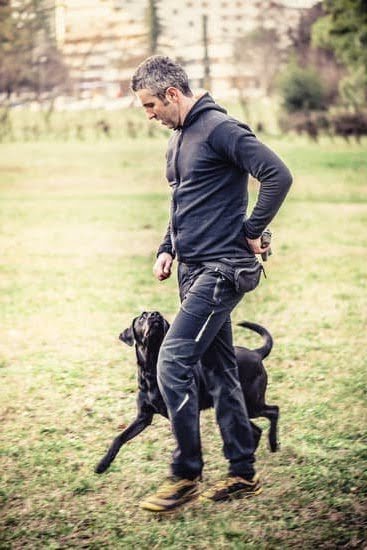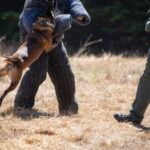Can you train a dog not to lift his leg? Understanding the behavior of leg lifting in dogs is essential to address this question. Leg lifting is a natural behavior for male dogs, and it can be challenging to train them out of it. In this article, we will explore the physiology behind leg lifting, the challenges of training, positive reinforcement techniques, and the importance of consistency in training routines.
When it comes to understanding the behavior of leg lifting in dogs, it’s important to recognize that it is a natural instinct driven by hormones and marking territory. While some dog owners may find this behavior undesirable, it’s crucial to approach training with patience and understanding.
In the following sections, we will address common misconceptions about training dogs not to lift their legs and provide practical advice on how to use positive reinforcement techniques. It’s important to remember that success in training your dog will require consistency, patience, and persistence as well.
The Physiology Behind Leg Lifting
When a male dog lifts his leg to urinate, it’s not just a random behavior – there are actually physiological reasons behind it. This behavior is linked to the dog’s need to mark his territory and communicate with other dogs in the area. By lifting their leg, male dogs can leave their scent higher up on trees, poles, or other objects, allowing them to advertise their presence to others.
Additionally, the act of leg lifting allows a male dog to better aim his urine at specific areas, which helps create a more potent and noticeable scent marker. This is important for communication and establishing dominance within the canine social structure. For female dogs, the act of squatting to urinate also serves as a way of marking territory but does not involve leg lifting due to differences in anatomy.
It’s important for dog owners to understand that this behavior is natural and instinctual for their pets. While training can help modify this behavior in certain situations, it’s crucial for pet owners to approach training with patience and understanding of why dogs engage in leg lifting in the first place.
| Physiological Reasons Behind Dog Leg Lifting | Significance |
|---|---|
| To mark territory and communicate with other dogs | Establishing presence and dominance |
| Aiming urine at specific areas for potent scent markers | Communication within the canine social structure |
| Differences in leg lifting behavior between male and female dogs | Varying anatomical considerations |
Challenges of Training
Addressing the challenges of training a dog not to lift his leg can be daunting, especially when there are common misconceptions about this behavior. One misconception is that it is impossible to train a dog not to lift his leg, as it is a natural instinct. However, with the right approach and techniques, it is entirely possible to modify your dog’s behavior.
Another challenge is the belief that punishment or scolding will stop the behavior. It’s important to understand that using negative reinforcement can often lead to anxiety and fear in your dog, which may exacerbate the behavior you’re trying to eliminate. Instead, positive reinforcement techniques should be utilized to encourage and reward alternative behaviors.
Additionally, some may underestimate the time and effort required for training. Consistency and patience are crucial in modifying your dog’s behavior. This means being persistent in your training routine and understanding that setbacks are normal in the process of behavioral modification. By addressing these common misconceptions, you can approach the challenge of training your dog with a better understanding of what it entails.
Positive Reinforcement Techniques
Training a dog not to lift his leg can be a challenging but achievable task with the right positive reinforcement techniques. Here are some effective methods to help your dog adopt a different behavior:
- Redirecting attention: When you notice your dog starting to lift his leg, quickly redirect his attention by using a command he knows well, such as “sit” or “down.” Offering a treat or a favorite toy can also help shift his focus away from the unwanted behavior.
- Using scent deterrents: Consider using scent deterrents in areas where your dog typically lifts his leg. There are several commercial products available that can discourage leg lifting due to their unpleasant smell for dogs.
- Clicker training: Clicker training can be an effective method for teaching your dog new behaviors. When your dog performs the desired action of not lifting his leg, use the clicker and offer a reward to reinforce the behavior.
Consistency is key when implementing these positive reinforcement techniques. It’s important to remain patient and persistent throughout the training process. Remember, every dog learns at their own pace, so it may take time for your furry friend to fully adopt a different behavior. Stay consistent with your chosen training method and be sure to celebrate even small successes along the way.
Seeking professional help from a reputable dog trainer may also be beneficial if you’re struggling to see progress with your training efforts. A professional trainer can provide personalized guidance and support based on your dog’s specific behavior and needs. With dedication and understanding, you can successfully train your dog not to lift his leg through positive reinforcement techniques.
Consistency Is Key
Training a dog not to lift his leg can be a challenging task that requires patience, dedication, and most importantly, consistency. It’s important to understand that changing a behavior that is natural to dogs will take time and effort. Establishing a training routine is crucial in ensuring that your dog successfully adapts to the new behavior.
One of the first steps in establishing a training routine is to set specific times for training sessions. Consistency in the timing of these sessions will help your dog understand when to expect the training, making it easier for him to adapt. Whether it’s once or twice a day, creating a regular schedule will reinforce the desired behavior.
In addition to setting specific times for training, it’s also important to be consistent in your commands and rewards. Use clear and concise commands each time you train your dog, reinforcing them with positive reinforcement such as treats or praise. This consistency will help your dog associate the new behavior with the commands given, making it more likely for him to adopt the desired action.
| Importance of Consistency | Benefits |
|---|---|
| Setting specific times for training sessions | Helps your dog understand when to expect training |
| Consistent use of commands and rewards | Helps establish associations between behavior and commands |
Dealing With Setbacks
Understanding the Nature of Setbacks
Training a dog not to lift his leg can be a challenging task, and setbacks are inevitable. It’s important to understand that setbacks are a natural part of the training process. Dogs, like humans, can have bad days, or they may revert to their old behavior when faced with certain triggers.
Staying Patient
When dealing with setbacks in training your dog not to lift his leg, patience is key. It’s easy to feel frustrated or discouraged when your dog doesn’t respond as quickly as you’d hoped. However, it’s essential to remain patient and understanding during the training process. Yelling at or punishing your dog for setbacks will only serve to confuse and stress them, making the training process even more challenging.
Being Persistent
Persistence is equally as important as patience when dealing with setbacks in training. Consistently reinforcing the desired behavior through positive reinforcement techniques is crucial for success. If your dog experiences a setback, simply reevaluate your training methods and continue practicing with consistency. Remember that every dog learns at their own pace, and it’s important to remain persistent in your efforts while staying positive and encouraging towards your furry friend.
Seeking Professional Help
If you’ve been struggling to train your dog not to lift his leg, and have tried various techniques without success, it may be time to consider seeking professional help. A dog trainer can provide valuable expertise, guidance, and support to address the behavior effectively. Here are some signs that indicate it’s time to seek the assistance of a professional:
- Your dog shows no improvement despite your consistent efforts and use of positive reinforcement techniques.
- You feel overwhelmed or frustrated by the lack of progress in training your dog not to lift his leg.
- Your dog’s behavior is causing disruptions in your home or affecting your relationship with others (e.g. soiling indoors, territorial marking).
When choosing a dog trainer, it’s essential to find someone who uses positive reinforcement methods and has experience in addressing behavioral issues such as leg lifting. Look for trainers who are certified or have credentials from reputable organizations, and who have a good reputation in the community. It’s also helpful to read reviews and seek recommendations from other pet owners. Investing in professional help can make a significant difference in helping your dog overcome this challenging behavior.
Remember that seeking professional help does not mean you’ve failed as a pet owner. In fact, recognizing when you need assistance and taking proactive steps to address the issue demonstrates your commitment to your dog’s well-being and happiness. With the right guidance from a skilled dog trainer, you can work towards modifying your dog’s behavior successfully.
Celebrating Success
Setting Realistic Expectations
When it comes to training your dog not to lift his leg, it’s important to set realistic expectations. Celebrating success in this journey means understanding that it may take time for your dog to unlearn a behavior that comes naturally to him. It’s likely that there will be setbacks along the way, but by remaining patient and consistent, you can help your dog adopt a different behavior.
Recognizing Progress
As you work with your dog on this training, it’s essential to celebrate the small victories along the way. If your dog shows any signs of adopting the new behavior, such as sniffing around without lifting his leg, make sure to acknowledge and reward him for it. Positive reinforcement is key in encouraging your dog to continue exhibiting the desired behavior.
Building a Strong Bond
Training your dog not to lift his leg can also be a great opportunity to strengthen the bond between you and your pet. The time and effort you put into training will allow you and your dog to work together toward a common goal, ultimately deepening your relationship. Remember that every step forward in this process is worth celebrating, as it reflects the trust and understanding between you and your furry friend.
Conclusion
In conclusion, training a dog not to lift his leg is a process that requires patience, understanding, and consistency. It’s important to recognize that leg lifting is a natural behavior for dogs, rooted in their physiology and instincts. While it may be challenging to change this behavior, it is not impossible with the right approach.
Positive reinforcement techniques have been shown to be effective in training dogs to adopt a different behavior. By rewarding desired behaviors and ignoring or redirecting unwanted ones, you can gradually teach your dog to engage in alternate actions. Consistency is key in this process; establishing a clear routine and sticking to it will help reinforce the new behavior you are trying to instill in your dog.
It’s crucial to remain patient and persistent throughout the training process. Setbacks are inevitable, but staying focused on the end goal and continuing with the established training routine will yield results over time. If you find yourself struggling or unable to make progress, don’t hesitate to seek professional help from a qualified dog trainer who can provide guidance and support.
Most importantly, celebrate each small success along the way as you work towards reshaping your dog’s behavior. Remember that understanding your dog’s natural instincts and being patient during the training process is essential for building a strong bond with your pet.
Frequently Asked Questions
Can You Stop a Male Dog From Lifting His Leg?
Yes, you can stop a male dog from lifting his leg to mark territory with some training and positive reinforcement. You can discourage this behavior by redirecting your dog’s attention, using positive reinforcement when he urinates in the appropriate spot, and possibly limiting access to areas where he tends to mark.
Do Male Dogs Always Lift Their Leg?
Not all male dogs lift their leg to urinate, but it is a common behavior in intact male dogs. Neutered male dogs may also exhibit this behavior, though it varies from dog to dog. Some male dogs may squat like females or even mark while walking.
How Do I Stop My Male Dog From Marking?
To stop your male dog from marking, you can start by having him evaluated by a veterinarian to rule out any underlying medical issues. Once medical causes are ruled out, consistent training and positive reinforcement can help discourage the behavior. Additionally, cleaning up any marked areas with an odor neutralizer can help eliminate the scent that encourages marking behaviors.

Welcome to the blog! I am a professional dog trainer and have been working with dogs for many years. In this blog, I will be discussing various topics related to dog training, including tips, tricks, and advice. I hope you find this information helpful and informative. Thanks for reading!





